Overall, our results show an industry that continues to struggle to replace retiring lab professionals at a sustainable rate while also facing challenges created by the recent pandemic. Although many are receiving annual compensation increases of 1% to 5%, a number of respondents indicated better salaries could help to alleviate the recruitment problem.
MORE: Download the full report as a PDF
Lighthouse’s intent with this project was to determine correlations between Medical Laboratory wages, morale, different departments, and experience levels following what has been a challenging few years for the lab industry.
“We want to provide medical lab professionals with good, actionable data that they can take back to their HR departments or managers to better understand the status of our industry,” explains Jon Harol, President of Lighthouse Lab Services. “We also hope to inform lab owners and decision-makers of the feedback we received to help guide their future compensation and staffing decisions.”
Harol will present further on the results of the survey during a press conference at 2 p.m. CDT on July 27 at the AACC Scientific Meeting in Chicago, Ill.
| Objectives: To inform the medical laboratory community of current levels of wages, staffing and overall satisfaction among lab professionals while also providing respondents with actionable data that can be used to inform future career choices. |
| Methods: Lighthouse Lab Services solicited and collected responses from lab professionals across our newsletters, social media, and other outreach channels. Respondents were given the option to submit their data anonymously. Wage data was primarily collected from respondents who identified as Lab Assistants, Technicians, Technologists, Managers, Administrative Lab Directors, and Medical Lab Directors. Somewhat surprisingly, a plurality of respondents (36%) indicated they have 21 or more years of experience as a lab professional. |
| Results: Because this is a first-time survey, the statistics cited in this report do not have a comparable internal reference point. That said, Lighthouse intends to conduct this survey annually moving forward. Results show a majority of respondents received salary increases in 2022, although it should be noted the vast majority who did receive a compensation increase saw modest bumps of 1% to 5% at a time when the U.S. economy battles rampant inflation. However, concerns over staffing levels and burnout remain significant. |
| Conclusion: As the pace of retirements increases in the coming years, the medical laboratory industry must do more to increase recruitment of new lab professionals. Part of this effort must include increasing the number of training programs and lab degrees offered nationwide after these programs have experienced attrition in recent years, limiting the number of pathways for potential new hires. In addition to recruitment, labs must also focus on maintaining proper staffing levels to avoid employee burnout and maintain morale. |
Demographics
In total, Lighthouse collected data from 1,112 respondents. Of those, 71% described their race/ethnicity as White/Caucasian, while 11% identified as Black or African American, and 7% as Asian or Pacific Islander. An additional 5% identified as Latino or Hispanic, with Native Americans, multiracial individuals, and those identified as “other or unlisted” comprising the remainder of the population. Regrettably, while both men and women are represented in the totals, Lighthouse did not collect data that will allow us to accurately represent those numbers during this survey.
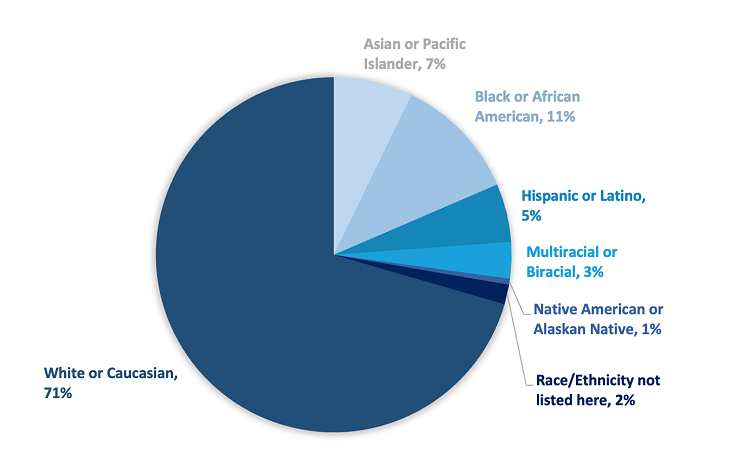
Respondents predominantly identified their roles as Technologists (49%), followed by Managers (21%), Technicians (17%), Administrative Lab Directors (7%), Medical Lab Directors (4%), and Lab Assistants (2%). Somewhat surprisingly, a plurality of respondents (36%) indicated they have 21 or more years of experience as a lab professional.
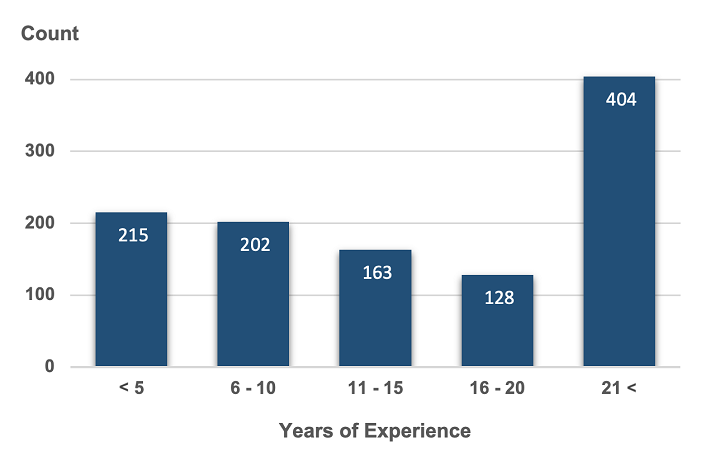
The vast majority of respondents (75%) said they work in a high-complexity lab, while 23% described their lab as moderate complexity. The remaining 2% work in waived-complexity labs.
Staffing impacting Medical Laboratory morale
According to our survey, 40% of respondents indicated their lab was moderately understaffed, while another 33% described their lab as significantly understaffed. Just 27% of respondents felt their lab was adequately or well-staffed. Unsurprisingly, the respondent’s perception of staffing levels had a direct correlation to their feelings of satisfaction, with those perceiving their lab’s staffing situation favorably more likely to express satisfaction with their role.
The following graph displays satisfaction levels among the 73% of respondents who described their lab as moderately or significantly understaffed. Of this group, 44% described themselves as extremely or moderately unsatisfied in their role, while another 24% stated their morale was neutral. Just 32% of respondents who felt their labs had staffing issues said they were moderately or extremely satisfied with their careers.
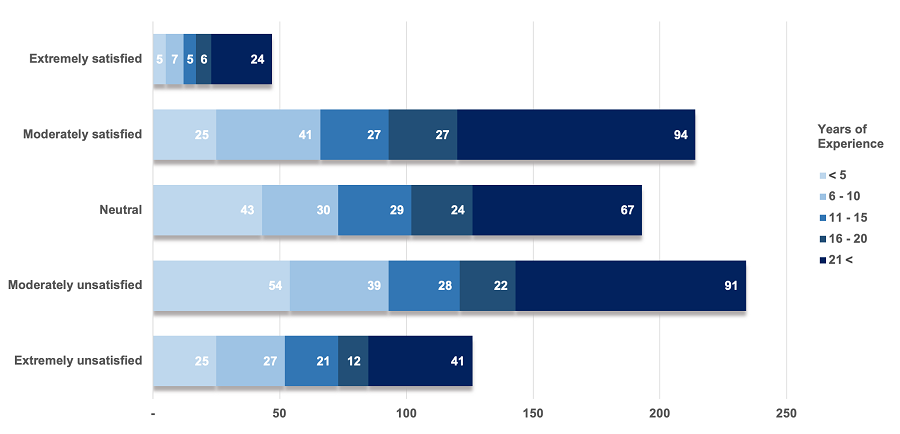
Many respondents said the lack of attention and investment put toward developing new medical lab professionals is finally having a highly visible impact after years of percolating as a looming issue.
“The Medical Lab Industry is now feeling the effects of the lack of investment in advocating for our profession early on,” wrote one respondent. “Many MT/MLS programs have closed and wages have never been appropriate for the level of education and responsibilities of an MT/MLS.”
Medical Laboratory wages by position
The national average reported compensation (excluding California) across all positions was $79,502. Due to pay rates that are typically higher than those of their peers, we have elected to present California compensation data as its own carveout. Compensation data for California respondents (61 total) shows an average salary of $121,730.
Overall, while the majority of respondents (72%) received a raise in the past year, most of those compensation increases were modest, with 59% saying their pay bump ranged from a 1% to 5% increase in their previous salary. As expected, those who did not receive a pay raise in the past year were the most likely to indicate higher levels of dissatisfaction within their position.
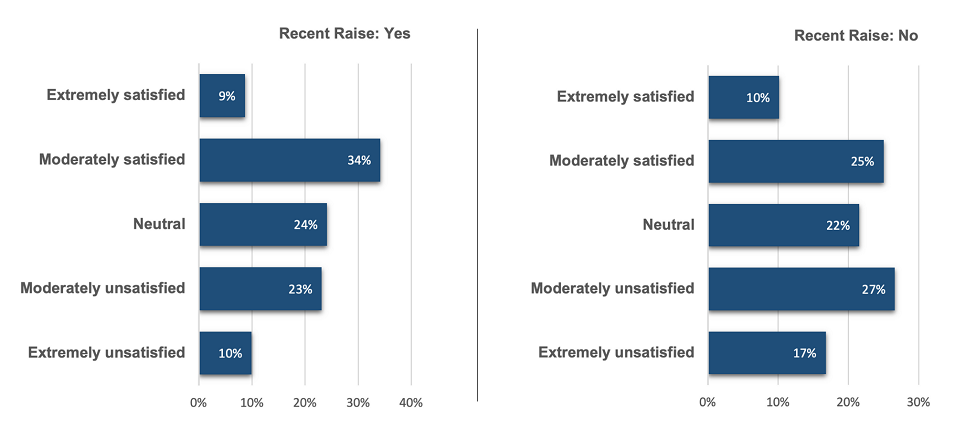
One recommendation offered by a respondent to those seeking better compensation early in their careers is to change jobs often.
“Most people should switch jobs frequently, at least at the beginning of their careers,” the respondent wrote. “Employers don’t give big raises, so any jumps in salary will come from switching jobs, and asking for a higher starting pay.”
Average rates by position/seniority level are broken out below:
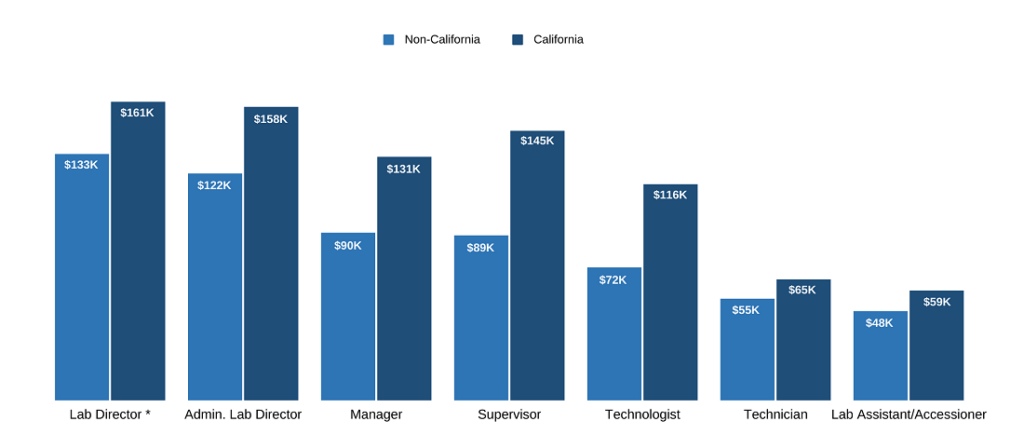
*The reported compensation average for Medical Lab Directors is significantly lower than what our internal database and publicly available figures show. For example, Salary.com cites the national median salary for Medical Directors at $298,000. Discrepancies between this data and the reported average likely reflects our limited sample pool for this position (44).
Morale lower among recent hires
Overall, morale amongst the total pool of respondents was slightly higher than anticipated, with 41% saying they are moderately or extremely satisfied in their current role. Just 36% describe themselves as moderately or extremely unsatisfied, while 23% said they feel neutral about current morale levels.
However, lab professionals with five or less years of experience were found to be less satisfied than their more experienced peers, with 41% describing being moderately or extremely unsatisfied and another 29% stating they’re neutral. One respondent said salaries offered for newer hires in most instances are still not in line with the education required to work in this field.
“Employers know what we bring to the table, and even so, still want to offer only $20-25 an hour for positions that require one to two degrees,” they wrote. “And there’s not enough proper training due to frequent turnover.”
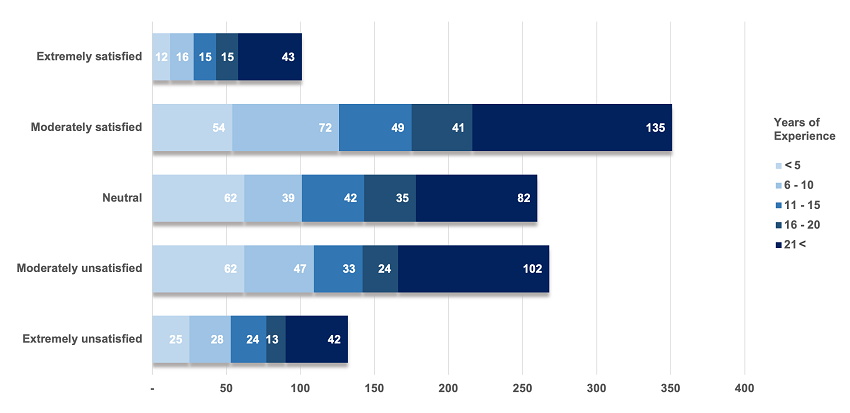
Conversely, those with 21 or more years of experience were found to be the most satisfied with their roles, as nearly 45% describes themselves as moderately or extremely satisfied. As expected, groups who reported perceived staffing issues and stagnating wages expressed higher levels of dissatisfaction than their peers.
Conclusion
As previously noted, while annual compensation increases have a direct positive impact on the morale of Medical Laboratory Professionals, the industry also must do more to increase recruitment of new individuals to alleviate significant concerns surrounding staffing issues. Better lab staffing industrywide could also reduce the amount of burnout being felt by the newest members of the industry who reported lower levels of morale than their more seasoned peers. In addition to recruitment efforts, the industry must also continue to advocate for more lab degrees and training programs to increase the staffing pipeline after many of these programs have been shuttered in recent years.


